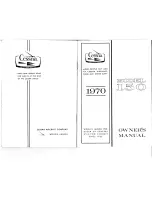
Adjustments – Hang Bracket Position :
Hang Bracket Position:
there are 4 hang bracket positions:
•
The wing becomes faster « brisk » by moving the wing hitching cubes forward. In flight, the
control bar, hands free (neutral bar position), will tend to move back from 3 to 5 centimeters
per adjustment step. Position 4 (closest to the front) is the fastest. While parked, the control
bar rests against the pilot seat.
•
The wing becomes slower, more « placid» by moving the wing hitching cubes backwards.
In flight, the control bar, hands free (neutral bar position), will tend to move forwards from 3
to 5 centimeters per adjustment step. Position 1 (closest the rear), is the most sedate.
While parked, the control bar rest against the wing stop on the top of the mast/pylon.
•
Two sets of horizontally drilled holes, spaced at 28 mm centers, allow 2 hang positions,
positions 1 and 3. The other two hang positions are obtained (2 and 4) by turning the two
keel blocking rings 90°. The two nylon blocking rings restrict the forward/aft movement of
the hitching cubes. The blocking ring drill holes are spaced at 14 mm centres. The M6
Nylock self-locking nuts MUST be changed after each use.
•
Each position change will increase or decrease the “hands free” speed by 5 km/h to 7 km/h.
•
Position n° 2 is the standard position
(i.e. the position where roll and pitch is most
consistent.)
Address
•
It is not recommend that the Aircraft be flown at MTOW in position n°1, because the ‘hands
free’ speed will be very close to the wing’s stall speed. Control deflections must be subtle.
The effort required to pull the control bar in will be more significant than in hang position
n°2.
•
At MTOW in position n°4, full front, the effort required to push the control bar out will be
more significant than in position of centering n°2. This effort MUST especially be taken into
account during takeoff and landing.
Washout:
the wing tip assembly is restrained using a screw. This adjustment is carried out during
the wing flight tests before delivery. It does not have to be changed.
Tension:
to correct a slight tendency of the wing to fly to the right or the left in flight, it is only
necessary to modify the tension of the shock cord of the upper-surface wing battens. Work on the
first 8 battens from the keel, by 2 battens at a time, conduct a flight test after each batten re-
tension.
•
Tighten the inside wing (the wing which is lower in a turn).
•
Loosen the outside wing (the wing which is higher in a turn)
Tightening the shock-cords causes the batten to compress, which increase the thickness of the
wing profile, increasing lift and therefore correcting the tendency to turn.
The tension of the shock-cords of the three last (outboard) upper surface battens, as well as the
batten at the wing tip (thicker cord), must be tight and identical on both the right and the left. (CF
Vibration).
Tension adjustments to the end of the leading edges (CHC 6 Screw) must be carried out identically
on both the right and on the left, at scheduled maintenance times (CF section 4 –01).
Note: the influence this these adjustments on flight symmetry is unimportant.
MAUT DYN 450
Edition : June 2005
Section : 3 - 03






































